5供应链管理-集成计划
供应链管理组织结构
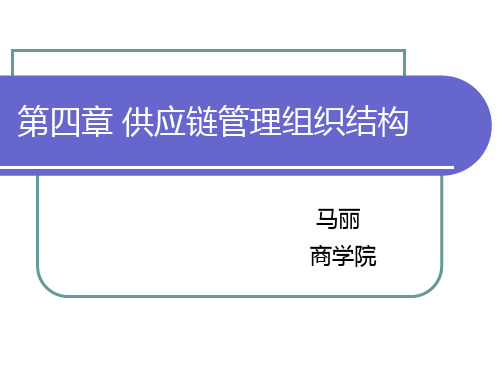
核心企业
核心企业
核心企业
核心企业
图4-11 扁平状网络组织结构
采购 供 应 合 同 供 应 商 管 理 供 应 商 管 理
库存 原 料 原 料 原 料 原 料
制造支持 物 料 配 送 包 装
成本
销售配送 销 售 运 输 订 单 处 理
客户服务 安 装 送 货 上 门 退 、 勘 货
完全一体化
所谓物流功能完全一体化组织,是指在一个高 层物流经理的领导下,统一所有的物流功能和 运作,将采购、储运、配送、物料管理等物流 的每一个领域组合构成一体化运作的组织单元, 形成总的企业内部一体化物流框架。
强调速度取胜,追求速度经济效应的获取,基础在 于组织的敏捷性特点
柔性化:对环境变化能及时地作出能动的反应
供应链管理组织设计原则
有效性原则
有效性原则是供应链管理组织设计原则的核 心,是衡量组织结构合理与否的基础。
合理管理幅度原则
一名管理者能够直接管辖的下属为8-15人
职责与职权对等原则 协调原则 稳定与适应结合原则
管理信息系统
物料需求计划 采购
物料仓储
运输 订单处理 配送系统计划
顾客信息系统
物料库存控制
图4-3 功能独立型管理组织
注:企业开始将核心的物资配送和物料管理的功能独立出 来,形成与财务、制造以及市场营销等相平行的专业部门 。
功能独立型组织
缺点:
物流职能管理和物流现场作业还是不能完全 统一,因为许多物流具体作业还是分散在生 产和营销活动之中的。
第三节 虚拟供应链管理组织
虚拟组织的概念
虚拟组织是一种区别于传统组织的以信息技 术为支撑的人机一体化组织。
集成化的供应链管理
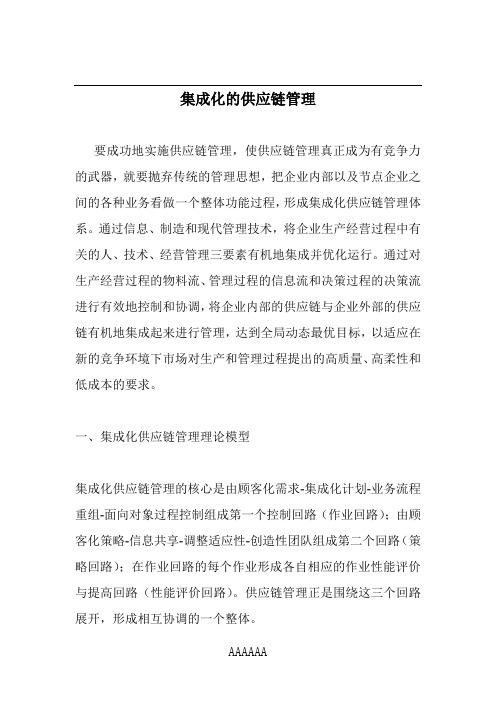
集成化的供应链管理要成功地实施供应链管理,使供应链管理真正成为有竞争力的武器,就要抛弃传统的管理思想,把企业内部以及节点企业之间的各种业务看做一个整体功能过程,形成集成化供应链管理体系。
通过信息、制造和现代管理技术,将企业生产经营过程中有关的人、技术、经营管理三要素有机地集成并优化运行。
通过对生产经营过程的物料流、管理过程的信息流和决策过程的决策流进行有效地控制和协调,将企业内部的供应链与企业外部的供应链有机地集成起来进行管理,达到全局动态最优目标,以适应在新的竞争环境下市场对生产和管理过程提出的高质量、高柔性和低成本的要求。
一、集成化供应链管理理论模型集成化供应链管理的核心是由顾客化需求-集成化计划-业务流程重组-面向对象过程控制组成第一个控制回路(作业回路);由顾客化策略-信息共享-调整适应性-创造性团队组成第二个回路(策略回路);在作业回路的每个作业形成各自相应的作业性能评价与提高回路(性能评价回路)。
供应链管理正是围绕这三个回路展开,形成相互协调的一个整体。
根据集成化思想,构建集成化供应链管理理论模型如图2-6所示。
调整适应性-业务重组回路中主要涉及供需合作关系、战略伙伴关系、供应链(重建)精细化策略等问题。
面向对象的过程控制-创造性团队回路中主要涉及面向对象的集成化生产计划与控制策略、基于价值增值的多级库存控制理论、资源约束理论在供应链中的应用、质量保证体系、群体决策理论等。
顾客化需求-顾客化策略回路中主要涉及的内容包括:满意策略与用户满意评价理论、面向顾客化的产品决策理论研究、供应链的柔性敏捷化策略等。
信息共享-同步化计划回路中主要涉及的内容包括:JIT供销一体化策略、供应链的信息组织与集成、并行化经营策略。
二、集成化供应链管理的实现(一)实施供应链管理要解决的若干问题目前企业要实施集成化供应链管理,就必须面对和解决许多有关供应链的问题,主要包括:※供应链的高成本(大约占净销售值的5%~20%)※库存水平过高(库存水平经常保持在3~5个月)※部门之间的冲突※目标重构※产品寿命周期变短※外部竞争加剧※经济发展的不确定性增加※价格和汇率的影响※用户多样化需求,等等要解决这些问题,真正实现集成化供应链管理,企业要进行以下几个方面的转变:(1)企业要从供应链的整体出发,考虑企业内部的结构优化问题;(2)企业要转变思维模式,从纵向一维空间思维向纵-横一体的多维空间思维方式转变;(3)企业要放弃\"小而全,大而全\"的封闭的经营思想,向与供应链中的相关企业建立战略伙伴关系为纽带的优势互补、合作关系转变;(4)企业要建立分布的、透明的信息集成系统,保持信息沟通渠道的畅通和透明度;(5)所有的人和部门都应对共同任务有共同的认识和了解,去除部门障碍,实行协调工作和并行化经营;(6)风险分担与利益共享。
供应链管理概述-供应链管理

供应链管理的实施目标之一,就是通过上下游企业 协调一致的运作,保证达到客户满意的服务水平, 吸引并保留客户,最终实现企业的价值最大化。
3、总库存成本最小化
按照JIT管理思想,库存是不确定性的产物,任何库 存都是浪费。因此,在实现供应链管理目标的同时, 要使整个供应链的库存控制在最低的程度。
总部设于美国俄亥俄州立大学的全球供 应链论坛将供应链管理定义成:
为消费者带来有价值的产品、服务以及信息 的、从源头供应商到最终消费者的集成业务 流程。
2.2供应链管理的内涵
2.2.1供应链管理的基本内涵 2.2.2供应链管理思想的体现 2.2.3如何理解供应链管理
2.2.1供应链管理的基本内涵
更加关注物流企业的参与
物流的作用特别重要,因为缩短物流周期比缩短制造周期 更关键。
2.2.2供应链管理思想的体现
一、信息管理 二、客户管理 三、库存管理 四、关系管理 五、风险管理
一、信息管理
在供应链中,信息是供应链各方的沟通载体, 供应链中各个阶段的企业就是通过信息这条纽 带集成起来,可靠、准确的信息是企业决策的 有力支持和依据,能有效降低企业运作中的不 确定性,提高供应链的反应速度。
供应链管理的主线是信息管理,信息管理的基 础是构建信息平台,实现信息共享,将供求信 息及时、准确地传达到供应链上的各个企业, 在此基础上进一步实现供应链的管理。
二、客户管理
在供应链管理中,客户管理是供应链管 理的起点,供应链源于客户需求,同时 也终于客户需求,因此供应链管理是以 满足客户需求为核心运作的。
供应链应是集成系统。
决定产品最终竞争力的冰山现象
冰山
产品在最终市 场上的竞争
供应链管理的五个发展阶段
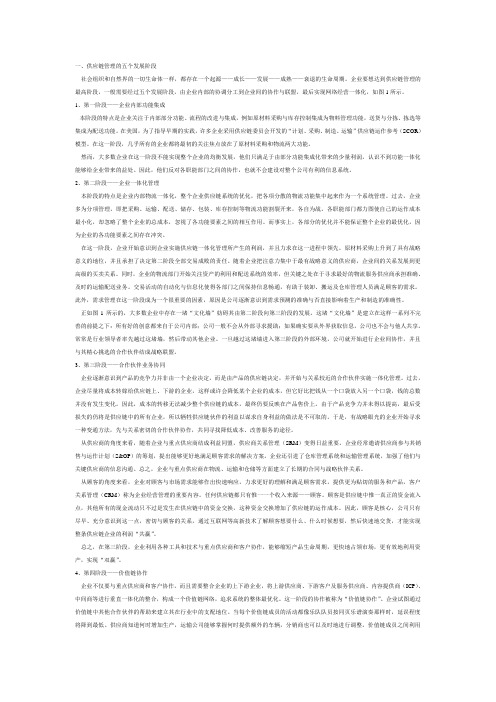
一、供应链管理的五个发展阶段社会组织和自然界的一切生命体一样,都存在一个起源——成长——发展——成熟——衰退的生命周期。
企业要想达到供应链管理的最高阶段,一般需要经过五个发展阶段,由企业内部的协调分工到企业间的协作与联盟,最后实现网络经营一体化,如图1所示。
1、第一阶段——企业内部功能集成本阶段的特点是企业关注于内部部分功能、流程的改进与集成,例如原材料采购与库存控制集成为物料管理功能,送货与分拣、拣选等集成为配送功能。
在美国,为了指导早期的实践,许多企业采用供应链委员会开发的“计划、采购、制造、运输”供应链运作参考(SCOR)模型。
在这一阶段,几乎所有的企业都将最初的关注焦点放在了原材料采购和物流两大功能。
然而,大多数企业在这一阶段不能实现整个企业的均衡发展,他们只满足于由部分功能集成化带来的少量利润,认识不到功能一体化能够给企业带来的益处。
因此,他们反对各职能部门之间的协作,也就不会建设对整个公司有利的信息系统。
2、第二阶段——企业一体化管理本阶段的特点是企业内部物流一体化,整个企业供应链系统的优化,把各项分散的物流功能集中起来作为一个系统管理。
过去,企业多为分项管理,即把采购、运输、配送、储存、包装、库存控制等物流功能割裂开来,各自为战。
各职能部门都力图使自己的运作成本最小化,却忽略了整个企业的总成本,忽视了各功能要素之间的相互作用。
而事实上,各部分的优化并不能保证整个企业的最优化,因为企业的各功能要素之间存在冲突。
在这一阶段,企业开始意识到企业实施供应链一体化管理所产生的利润,并且力求在这一进程中领先。
原材料采购上升到了具有战略意义的地位,并且承担了决定第二阶段全部交易成败的责任。
随着企业把注意力集中于最有战略意义的供应商,企业间的关系发展到更高级的买卖关系。
同时,企业的物流部门开始关注资产的利用和配送系统的效率,但关键之处在于寻求最好的物流服务供应商承担准确、及时的运输配送业务。
交易活动的自动化与信息化使得各部门之间保持信息畅通,有助于装卸、搬运及仓库管理人员满足顾客的需求。
公司今后五年供应链管理工作发展规划
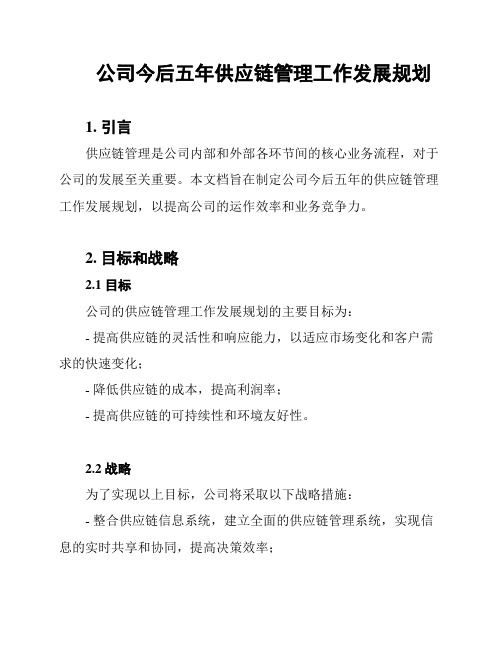
公司今后五年供应链管理工作发展规划1. 引言供应链管理是公司内部和外部各环节间的核心业务流程,对于公司的发展至关重要。
本文档旨在制定公司今后五年的供应链管理工作发展规划,以提高公司的运作效率和业务竞争力。
2. 目标和战略2.1 目标公司的供应链管理工作发展规划的主要目标为:- 提高供应链的灵活性和响应能力,以适应市场变化和客户需求的快速变化;- 降低供应链的成本,提高利润率;- 提高供应链的可持续性和环境友好性。
2.2 战略为了实现以上目标,公司将采取以下战略措施:- 整合供应链信息系统,建立全面的供应链管理系统,实现信息的实时共享和协同,提高决策效率;- 加强与供应商和物流合作伙伴的关系,建立稳定的合作框架,共同提高供应链的绩效和效率;- 提高供应链的可见性,通过技术手段和流程优化,对整个供应链进行实时监控和管理;- 不断创新和优化供应链的流程和策略,以提高交付时间、降低库存和减少成本;- 提倡可持续性发展理念,通过选择环保材料、减少能源消耗等措施,推进可持续供应链管理。
3. 实施计划公司将按照以下计划逐步推进供应链管理工作的发展:- 第一年:建立供应链信息系统,集成各个部门的数据和资源,建立供应链的基础框架。
- 第二年:加强与供应商和物流合作伙伴的合作,建立稳定的供应链协同机制,并进行供应链的性能评估和优化。
- 第三年:通过引入先进的技术手段,提高供应链的可见性和监控能力,实现供应链管理的实时化。
- 第四年:优化供应链的流程和策略,通过持续改进和创新,提高供应链的交付时间、库存管理和成本控制。
- 第五年:推进可持续供应链管理,在产品设计、供应商选择和物流渠道等方面加强环境责任和可持续性发展。
4. 风险管理在实施供应链管理工作发展规划过程中,公司需要注意以下风险:- 技术风险:供应链信息系统的建立和运维可能面临技术挑战,公司需提前进行风险评估并制定相应应对措施。
- 合作伙伴风险:与供应商和物流合作伙伴的合作可能面临信任和稳定性的问题,公司需建立合适的合作机制并定期评估供应链合作伙伴的表现。
集成化供应链管理理论模型
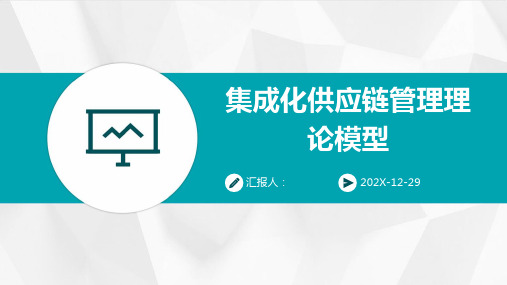
对未来研究的展望
随着全球化和信息化的发展,集成化供应链管理的应用范 围和深度将不断拓展,未来研究可以进一步探讨其在不同 行业、不同国家的应用情况和效果。
随着技术的不断创新,如物联网、大数据、人工智能等, 未来研究可以探索如何将这些技术应用于集成化供应链管 理中,提高供应链的智能化和自动化水平。
供应商管理
集成化供应链管理有助于制造业更好地管理供应商 ,确保原材料的供应稳定、质量可靠,降低采购成 本。
库存管理
集成化供应链管理可以实现库存的实时监控 和预测,降低库存成本,提高库存周转率。
零售业的集成化供应链管理
销售预测与需求管理
通过集成化供应链管理,零售业可以对销售数据进行实时 分析,预测市场需求,优化库存结构,提高客户满意度。
信息共享
通过信息技术手段实现供应链各环节信息的实时共享,提 高信息传递的准确性和效率。
跨组织协同
集成化供应链管理强调不同组织间的协同合作,打破组织 边界,实现信息流、物流、资金流的畅通。
资源优化
通过对供应链资源的整合和优化,实现整体效益的最大化 。
集成化供应链管理的必要性
提高企业竞争力
通过集成化供应链管理,企业能 够更好地应对市场变化,提高响 应速度,增强竞争力。
降低成本
通过资源整合和优化,降低库存 成本、运输成本等,提高整体运 营效率。
提升客户满意度
通过信息共享和流程协同,提高 客户服务水平,满足客户需求, 提升客户满意度。
集成化供应链管理的优势
提高运营效率
01
通过信息共享和流程协同,减少重复和浪费,提高运
供应链管理(第5版)课后习题答案
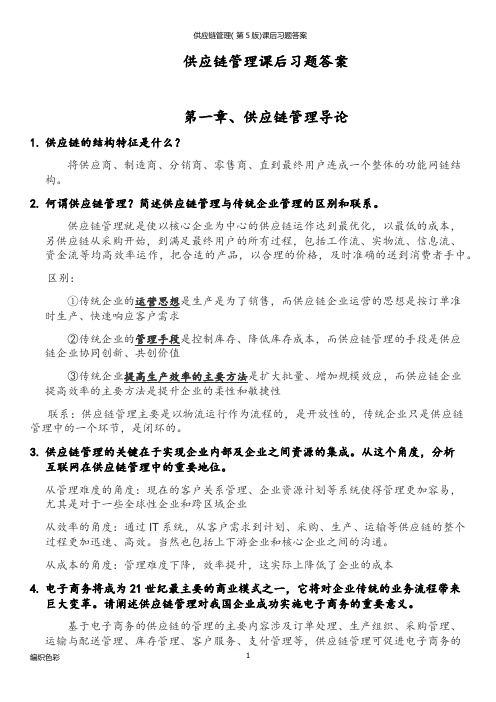
供应链管理课后习题答案第一章、供应链管理导论1.供应链的结构特征是什么?将供应商、制造商、分销商、零售商、直到最终用户连成一个整体的功能网链结构。
2.何谓供应链管理?简述供应链管理与传统企业管理的区别和联系。
供应链管理就是使以核心企业为中心的供应链运作达到最优化,以最低的成本,另供应链从采购开始,到满足最终用户的所有过程,包括工作流、实物流、信息流、资金流等均高效率运作,把合适的产品,以合理的价格,及时准确的送到消费者手中。
区别:①传统企业的运营思想是生产是为了销售,而供应链企业运营的思想是按订单准时生产、快速响应客户需求②传统企业的管理手段是控制库存、降低库存成本,而供应链管理的手段是供应链企业协同创新、共创价值③传统企业提高生产效率的主要方法是扩大批量、增加规模效应,而供应链企业提高效率的主要方法是提升企业的柔性和敏捷性联系:供应链管理主要是以物流运行作为流程的,是开放性的,传统企业只是供应链管理中的一个环节,是闭环的。
3.供应链管理的关键在于实现企业内部及企业之间资源的集成。
从这个角度,分析互联网在供应链管理中的重要地位。
从管理难度的角度:现在的客户关系管理、企业资源计划等系统使得管理更加容易,尤其是对于一些全球性企业和跨区域企业从效率的角度:通过IT系统,从客户需求到计划、采购、生产、运输等供应链的整个过程更加迅速、高效。
当然也包括上下游企业和核心企业之间的沟通。
从成本的角度:管理难度下降,效率提升,这实际上降低了企业的成本4.电子商务将成为21世纪最主要的商业模式之一,它将对企业传统的业务流程带来巨大变革。
请阐述供应链管理对我国企业成功实施电子商务的重要意义。
基于电子商务的供应链的管理的主要内容涉及订单处理、生产组织、采购管理、运输与配送管理、库存管理、客户服务、支付管理等,供应链管理可促进电子商务的发展,使资源在供应链网络中合理流动,来缩短交货周期、降低库存,并且通过提供自助交易的自助式服务以降低成本,提高速度和精确性,增强企业竞争力。
集成化供应链管理实现的步骤

集成化供应链管理实现的步骤
集成化供应链管理是一种有效管理供应链的方法,通过整合各个环节的资源和流程,
实现供应链的高效协同和更优的绩效。
下面是实现集成化供应链管理的步骤:
1. 改变思维方式。
集成化供应链管理的实现需要从传统的单纯关注产品、生产和配
送转变为跨越供应链的思维方式。
建立合作伙伴关系,协同相互整合和提高供应链的效益。
2. 优化供应链流程。
通过深入了解供应链的各个环节,并不断的分析流程,不断优
化各个环节的流程,从而提高供应链的效率,并且减少冗余及浪费的环节,提升成本效益。
3. 加强信息技术支持。
实现集成化供应链管理需要借助信息技术手段,比如ERP(企业资源计划)、CRM(客户关系管理系统)等技术。
通过数据集成,信息共享和协同工作,实现更加高效、智能的供应链管理。
4. 与供应商和客户建立紧密的联系。
与供应商和客户建立互信,互利的合作关系,
共同优化供应链网络,进行长期稳定的合作。
5. 加强供应链成本和风险控制。
建立灵敏的管理机制,强化成本和风险控制,建立
完整的预警和报告机制,以便快速响应风险事件,提高赢利能力。
6. 统一供应链管理标准。
针对集成化供应链管理,还需要建立整体性的标准。
标准
的制定涉及到数据标准、协调流程标准、业务标准等多个方面,但是为了保证集成化供应
链管理的高效性和稳定性,制定标准是非常必要的。
总之,集成化供应链管理是一个系统性的企业管理模式,实现这一模式需要企业持续
的改善和优化,满足不断变化的市场需求。
集成化供应链管理5阶段
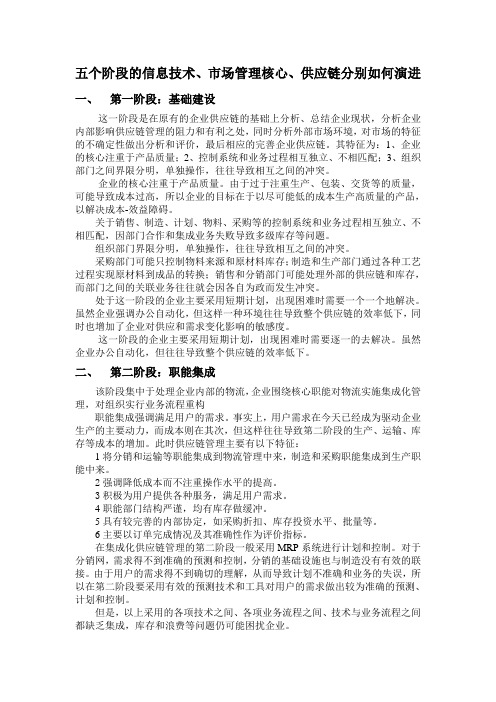
五个阶段的信息技术、市场管理核心、供应链分别如何演进一、第一阶段:基础建设这一阶段是在原有的企业供应链的基础上分析、总结企业现状,分析企业内部影响供应链管理的阻力和有利之处,同时分析外部市场环境,对市场的特征的不确定性做出分析和评价,最后相应的完善企业供应链。
其特征为:1、企业的核心注重于产品质量;2、控制系统和业务过程相互独立、不相匹配;3、组织部门之间界限分明,单独操作,往往导致相互之间的冲突。
企业的核心注重于产品质量。
由于过于注重生产、包装、交货等的质量,可能导致成本过高,所以企业的目标在于以尽可能低的成本生产高质量的产品,以解决成本-效益障碍。
关于销售、制造、计划、物料、采购等的控制系统和业务过程相互独立、不相匹配,因部门合作和集成业务失败导致多级库存等问题。
组织部门界限分明,单独操作,往往导致相互之间的冲突。
采购部门可能只控制物料来源和原材料库存;制造和生产部门通过各种工艺过程实现原材料到成品的转换;销售和分销部门可能处理外部的供应链和库存,而部门之间的关联业务往往就会因各自为政而发生冲突。
处于这一阶段的企业主要采用短期计划,出现困难时需要一个一个地解决。
虽然企业强调办公自动化,但这样一种环境往往导致整个供应链的效率低下,同时也增加了企业对供应和需求变化影响的敏感度。
这一阶段的企业主要采用短期计划,出现困难时需要逐一的去解决。
虽然企业办公自动化,但往往导致整个供应链的效率低下。
二、第二阶段:职能集成该阶段集中于处理企业内部的物流,企业围绕核心职能对物流实施集成化管理,对组织实行业务流程重构职能集成强调满足用户的需求。
事实上,用户需求在今天已经成为驱动企业生产的主要动力,而成本则在其次,但这样往往导致第二阶段的生产、运输、库存等成本的增加。
此时供应链管理主要有以下特征:1将分销和运输等职能集成到物流管理中来,制造和采购职能集成到生产职能中来。
2强调降低成本而不注重操作水平的提高。
3积极为用户提供各种服务,满足用户需求。
供应链管理涉及的内容
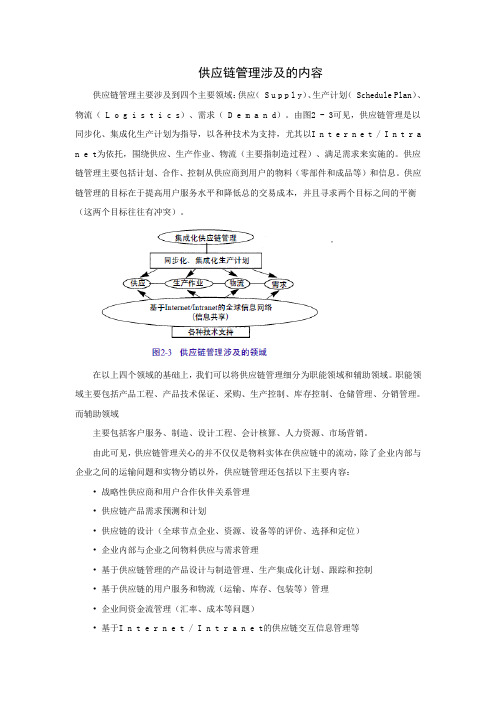
供应链管理涉及的内容供应链管理主要涉及到四个主要领域:供应( S u p p l y)、生产计划( Schedule Plan)、物流( L o g i s t i c s)、需求( D e m a n d)。
由图2 - 3可见,供应链管理是以同步化、集成化生产计划为指导,以各种技术为支持,尤其以I n t e r n e t / I n t r a n e t为依托,围绕供应、生产作业、物流(主要指制造过程)、满足需求来实施的。
供应链管理主要包括计划、合作、控制从供应商到用户的物料(零部件和成品等)和信息。
供应链管理的目标在于提高用户服务水平和降低总的交易成本,并且寻求两个目标之间的平衡(这两个目标往往有冲突)。
在以上四个领域的基础上,我们可以将供应链管理细分为职能领域和辅助领域。
职能领域主要包括产品工程、产品技术保证、采购、生产控制、库存控制、仓储管理、分销管理。
而辅助领域主要包括客户服务、制造、设计工程、会计核算、人力资源、市场营销。
由此可见,供应链管理关心的并不仅仅是物料实体在供应链中的流动,除了企业内部与企业之间的运输问题和实物分销以外,供应链管理还包括以下主要内容:•战略性供应商和用户合作伙伴关系管理•供应链产品需求预测和计划•供应链的设计(全球节点企业、资源、设备等的评价、选择和定位)• 企业内部与企业之间物料供应与需求管理• 基于供应链管理的产品设计与制造管理、生产集成化计划、跟踪和控制• 基于供应链的用户服务和物流(运输、库存、包装等)管理• 企业间资金流管理(汇率、成本等问题)• 基于I n t e r n e t / I n t r a n e t的供应链交互信息管理等供应链管理注重总的物流成本(从原材料到最终产成品的费用)与用户服务水平之间的关系,为此要把供应链各个职能部门有机地结合在一起,从而最大限度地发挥出供应链整体的力量,达到供应链企业群体获益的目的。
三、供应链管理与传统管理模式的区别供应链管理与传统的物料管理和控制有着明显的区别,主要体现在以下几个方面:(1)供应链管理把供应链中所有节点企业看作一个整体,供应链管理涵盖整个物流的、从供应商到最终用户的采购、制造、分销、零售等职能领域过程(如图2 - 4所示)。
集成化供应链管理流程详解

集成化供应链管理流程详解集成化供应链管理是指通过信息技术的支持,将企业的内部各部门、供应商、物流企业和销售渠道等所有关键节点联在一起,全面协调和管理企业的供应链活动,从而实现供应链的高效运营和业务协同。
整合内外部企业资源:集成化供应链管理流程的第一步是整合内外部企业资源。
企业内部的各个职能部门(如采购、生产、仓储、销售等)以及外部供应商、物流企业和销售渠道等都是供应链的重要组成部分。
因此,建立起一个有效的信息共享平台,对于整合这些资源至关重要。
需求计划和供需匹配:基于客户需求的预测,制定供应链的需求计划和供需匹配策略。
将产品分解成一系列关键零部件,制定必要的采购计划并协调生产计划。
这样可以确保所需零部件和成品能够按时供应和生产,并实现最佳物流成本。
供应商管理:有效的供应商管理可以确保合理的采购成本,并在供应链中实现合理的协调。
选择合适的供应商,建立供应商评估指标,监控供应商绩效表现,及时调整采购计划。
物流管理:货物流转的管理对供应链流程至关重要,物流管理应从最优化仓库管理开始,进一步的,应针对不同的需求,包括内部仓库、外部仓库、移动物流和配送等方面,制定适当的方针和措施以提高效率和满足用户快速交付的需求。
销售和营销管理:销售和营销活动是推动供应链运作的主要因素之一。
集成化供应链管理流程应该掌握与客户的直接联系来进行渠道管理,以满足客户个性化需求的同时,也可以增强销售效果。
总结:集成化供应链管理提出了高度集成的需求,不仅需要企业内部不同部门之间的协作,还需要与外界不同的合作伙伴之间的联系。
信息化技术是实现集成的必要工具,其综合利用将为企业创造价值并保持核心竞争力提供一定的保障。
供应链管理涉及的内容
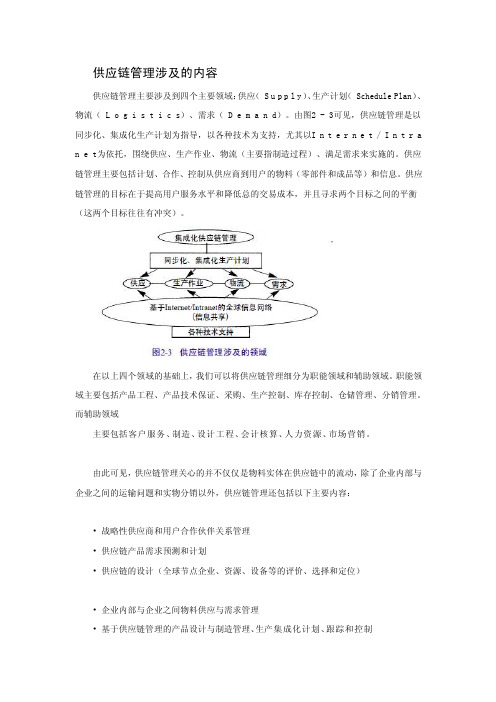
供应链管理涉及的内容供应链管理主要涉及到四个主要领域:供应( S u p p l y)、生产计划( Schedule Plan)、物流( L o g i s t i c s)、需求( D e m a n d)。
由图2 - 3可见,供应链管理是以同步化、集成化生产计划为指导,以各种技术为支持,尤其以I n t e r n e t / I n t r a n e t为依托,围绕供应、生产作业、物流(主要指制造过程)、满足需求来实施的。
供应链管理主要包括计划、合作、控制从供应商到用户的物料(零部件和成品等)和信息。
供应链管理的目标在于提高用户服务水平和降低总的交易成本,并且寻求两个目标之间的平衡(这两个目标往往有冲突)。
在以上四个领域的基础上,我们可以将供应链管理细分为职能领域和辅助领域。
职能领域主要包括产品工程、产品技术保证、采购、生产控制、库存控制、仓储管理、分销管理。
而辅助领域主要包括客户服务、制造、设计工程、会计核算、人力资源、市场营销。
由此可见,供应链管理关心的并不仅仅是物料实体在供应链中的流动,除了企业内部与企业之间的运输问题和实物分销以外,供应链管理还包括以下主要内容:•战略性供应商和用户合作伙伴关系管理•供应链产品需求预测和计划•供应链的设计(全球节点企业、资源、设备等的评价、选择和定位)• 企业内部与企业之间物料供应与需求管理• 基于供应链管理的产品设计与制造管理、生产集成化计划、跟踪和控制• 基于供应链的用户服务和物流(运输、库存、包装等)管理• 企业间资金流管理(汇率、成本等问题)• 基于I n t e r n e t / I n t r a n e t的供应链交互信息管理等供应链管理注重总的物流成本(从原材料到最终产成品的费用)与用户服务水平之间的关系,为此要把供应链各个职能部门有机地结合在一起,从而最大限度地发挥出供应链整体的力量,达到供应链企业群体获益的目的。
三、供应链管理与传统管理模式的区别供应链管理与传统的物料管理和控制有着明显的区别,主要体现在以下几个方面:(1)供应链管理把供应链中所有节点企业看作一个整体,供应链管理涵盖整个物流的、从供应商到最终用户的采购、制造、分销、零售等职能领域过程(如图2 - 4所示)。
供应链管理的概念内容及意义

(一)供应链管理的含义和特征1.供应链管理的含义供应链管理(Supply Chain Management,SCM是以提高企业个体和供应链整体的长期绩效为目标,对传统的商务活动进行总体的战略协调,对特定公司内部跨职能部门边界的运作和在供应链成员中跨公司边界的运作进行战术控制的过程。
供应链管理就是要整合供应商、创造部门、库存部门和配送商等供应链上的诸多环节,减少供应链的成本,促进物流和信息流的交换,以求在正确的时间和地点,生产和配送适当数量的正确产品,提高企业的总体效益。
供应链管理通过多级环节,提高整体效益。
每一个环节都不是孤立存在的,这些环节之间存在着错综复杂的关系,形成网络系统。
同时这个系统也不是静止不变的,非但网络间传输的数据不断变化,而且网络的构成模式也在实时进行调整。
2.供应链管理的特征(1)以顾客满意为最高目标,以市场需求的拉动为原动力;(2)企业之间关系更为密切,共担风险,共享利益;(3)把供应链中所有节点企业作为一个整体进行管理;库存原材料在制品分销销售点最终供应商采购创造分销零售用户图 1-4 供应链管理的范围(4)对工作流程、实物流程和资金流程进行设计、执行、修正和不断改进;(5)利用信息系统优化供应链的运作;(6)缩短产品完成时间,是生产尽量贴近实时需求;(7)减少采购、库存、运输等环节的成本。
以上特征中,(1)(2)(3)是供应链管理的实质,(4)(5)是实施供应链管理的两种主要方法,而(6) (7)则是实施供应链管理的主要目标,即从时间和成本两个方面为产品增值,从而增强企业的竞争力。
作为供应链中各节点企业相关运营活动的协调平台,供应链管理应把重点放在以下几个方面:(一) 供应链战略管理。
供应链管理本身属于企业战略层面的问题,因此,在选择和参与供应链时,必须从企业发展战略的高度考虑问题。
它涉及企业经营思想,在企业经营思想指导下的企业文化发展战略、组织战略、技术开辟与应用战略、绩效管理战略等,以及这些战略的具体实施。
供应链管理
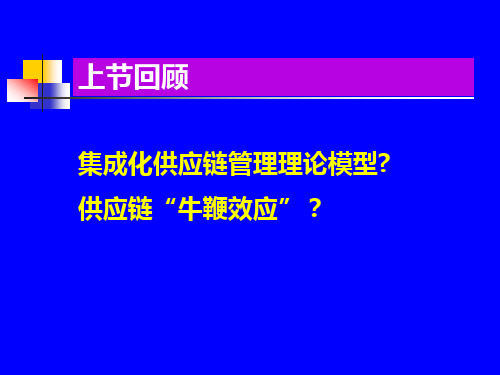
上节知识回顾
集成化供应链管理实现的步骤
Five stages: Stage1:基础建设 Stage2:职能集成 Stage3:内部供应链集成 Stage4:外部供应链集成 Stage5:集成化供应链动态联盟
上节知识回顾
供应链“牛鞭效应”(Bull-whip effect)是 相对于供应链协调而言的。供应链协调要求所 有阶段采取的行动以供应链总利润最大化为目 标。一旦不同阶段只注重局部目标的最优化或 信息在供应链传递过程中发生扭曲,供应链就 会出现失调。我们称订单规模在零售商——批 发商——制造商——供应商这一流动过程中波 幅递增的现象为牛鞭效应。
上节回顾
集成化供应链管理理论模型? 供应链“牛鞭效应”?
上节知识回顾
集成化供应链管理理论模型
三个回路 1.作业回路 顾客化需求——集成化计划—— 业务流程重组——面向对象过程控制 2.策略回路 顾客化策略——信息共享—— 调整适应性——创造性团队 3.性能评价回路 即作业性能评价与提高
调整 适应
第一节 供应链构建的体系框架
1、供应链管理的组织模型 2、供应链环境下生产运作与管理 3、供应链管理环境下的物流管理 4、基于供应链的信息支持系统
第一节 供应链构建的体系框架
第二节 供应链设计的原则
供应链设计的原则
• 自顶向下的设计和自底向上相结合的设计原则: - 自顶向下:从全局到局部→分解与协调原则 - 自底向上:从局部到整体→集成优化原则
性
协调性评价 业务重组
价值增值性
面向对象 过程控制
集成化 供应链管理
创造 性
集成化计划
信
息
同步性评
共
价
享
顾客化需求
供应链

供应链管理第一章供应链:供应链是围绕核心企业,通过对信息流、物流、资金流的控制,从采购原材料开始,制成中间产品以及最终产品,最后由销售网络把产品送到消费者手中的将供应商、制造商、分销商、零售商、直到最终用户连成一个整体的功能网链结构模式。
供应链的特征:复杂性、动态性、交叉性、面向客户需求。
供应链的类型:稳定的供应链和动态的供应链;平衡的供应链和倾斜的供应链;有效的供应链和反应性的供应链。
供应链流程分析:1环节法;2推/拉法。
推拉边界(顾客需求切入点):装配与发运之间;加工与装配之间;原材料采购与零部件加工之间;设计与采购之间;设计阶段之前。
环节:获取环节——生产环节——补充库存环节——顾客订购环节阶段:供应商————制造商———分销商——-———零售商——————顾客供应链管理:利用计算机网络技术全面规划供应链中的商流、物流、资金流、信息流等,并进行组织、协调、控制。
供应链管理思想理解:1信息管理;2客户管理;3库存管理;4关系管理;5风险管理。
供应链管理目标:1总成本最低化;2客户服务最优化;3总库存成本最小;4总周期最短化;5物流质量最优化。
第二章价值链:一个企业用来进行设计、生产、营销、交货及维修其产品的各种活动的集合。
一.基本活动:1内部物流(原材料搬运、仓储、库存控制、车辆调度、向供应商退货);2生产作业(机械加工、包装、组装、设备维护、检测、印刷、设施管理);3外部物流(产成品库存管理、交运、送货车辆调度、订单处理、生产进度安排);4市场和销售(广告、销售);5服务(安装调试、维修、培训、零部件供应)。
二.辅助活动:1采购;2技术开发(研发、改善产品的努力);3人力资源管理(人员招聘、雇佣);4企业基础设施(总体管理、计划、财务、会计、法律、政府事务、质量管理)。
价值链特征:增值链、电子链、协作链、虚拟链。
价值链内容分析:一.1在供应过程中,企业与供应商之间在其供应链中创造价值得过程;2在产品生产制造过程中,各环节、各单位创造价值的过程;3在产品销售过程中,在企业与顾客的链式结构中创造价值的过程;4在市场的调查、研究、开发以及产品的促销与分销等活动中创造价值的过程。
集成化供应链

华为集成化供应链管理
41
集成化供应链系统设计
1 基本概念
2
3
ISCM系统的功能模块设计
基亍Internet/Intranet的ISCM
42
SCSP的定义
SCSP(Supply Chain System Planning),供应链系统规划, 指的是企业为了实现目标顾客效用最大化目标,在一定
EDI阶段的集成化 供应链
构建在 Internet/Intranet 上的集成化供应链
2、集成化供应链的发展阶段
• 2.1 组建在MIS系统之上的初级集成化供应链
原材料供应
原材料批发
原材料分销
内成 部品 生 产 系商 统
MIS
财 务 子 系 统
销 售 子 系 统
生 产 子 系 统
……
库 存 子 系 统
集成化供应链劢态联盟
基础 建设 职能集成
集成化供应链劢态联盟 内部供应 链集成 外部供应 链集成
集成化供应链
集成化供应链概述
基本概念、OLAP定义、OLAP特点
集成化供应链理论模型
OLTP系统和OLAP系统的比较
集成化供应链管理的实现
基础建设 职能集成 内部集成 外部集成 动态联盟
集成化供应链系统设计
2
集成化供应链概述
1
2
集成化供应链的基本概念 集成化供应链的发展阶段 三种供应链模式的比较 集成化供应链的实施和应用
3
4
1、集成化供应链的基本概念
• 1.1 集成化供应链的定义
• 集成化供应链管理是围绕核心企业,通过对物流、信息流、资金流和知 识流的控制,从采购原材料开始,制成中间产品及最终产品,最后由销售网 络将产品送到消费者手中的将供应商、制造商、分销商、零售商、直至最终 用户连成一个整体的功能网链结构模式。
- 1、下载文档前请自行甄别文档内容的完整性,平台不提供额外的编辑、内容补充、找答案等附加服务。
- 2、"仅部分预览"的文档,不可在线预览部分如存在完整性等问题,可反馈申请退款(可完整预览的文档不适用该条件!)。
- 3、如文档侵犯您的权益,请联系客服反馈,我们会尽快为您处理(人工客服工作时间:9:00-18:30)。
Managing demand
In many instances, supply chain can influence demand in different periods of the year using pricing and other forms of promotion. The promotion result:
Need information
Demand forecast Ft for each period t in the planning horizon that extends over T period. Production costs:
– Labor, regular time and over time ($/hour) – Cost of subcontracting production($/unit) – Cost of changing capacity, specifically, hiring/laying
off workforce($/worker) and adding or reducing machine capacity($/machine)
Labor/machine hours required per unit Inventory holding cost Stockout or backlog cost Constraints: limits on overtime, layoffs, capital available, stockouts and backlogs.
集成化供应链管理的制造商、供应商、分销商信息交换 与处理示意图
需求方 发来的浏览请求 Internet 制造商生产与 库存信息处理 企业内部 浏览 销售商(用户)订货 Internet 向供应方 发出的数据 Internet 向供应商发布 采购需求信息 处理
用户和订货信息下载
主生产计划
物料需求计划
Managing supply
Production capacity inventory
பைடு நூலகம்
Managing capacity
When managing capacity to meet predictable variability, firms use a combination of the following approaches:
– Time flexibility from workforce.
– Use of seasonal workforce – Use of subcontracting
– Use of dual facilities----dedicated and flexible
– Designing product flexibility into the production
processes.
Managing inventory
When managing inventory to meet predictable variability, firms use a combination of the following approaches:
– Using common components across multiple
solutions to predictable variability in practice
Coordinate marketing and operations. (Cost and overall balance) Take predictable variability into account when making strategic decisions.(what type of products to offer, whether to build new facilities, and what sort of pricing structure a company should have) Preempt, do not just react to, predictable variability
(2)投入出产计划——能力需求分析(细能力平 衡)——投入出产计划 (3)投入出产计划——车间作业计划——生产进度 状态——投入出产计划
供应链管理下生产计划的信息流
(1)主生产计划——供应链企业粗能力平衡——主生产计划
(2)主生产计划——外包工程计划——外包工程进度——主 生产计划
(3)外包工程计划——主生产计划——供应链企业生产能力 平衡——外包工程计划 (4)投入出产计划——供应链企业能力需求分析(细能力平 衡)——投入出产计划
products. – Build inventory of high demand or predictable demand products. (when most of the products a firm produces have the same peak demand season.
Impact on timing of promotion During low demand periods Peak demand
High ability to grow overall market Peak demand High margin High holding costs High cost of changing capacity Peak demand Low demand Low demand
Time flexibility from workforce or capacity strategy----using utilization as the lever.
– When inventor carrying costs are relatively high and
capacity is relatively inexpensive.能力战略
是否转包
外包工程
外包生产计划
外部资源
自制工程 外包制造工程 外包工程进度 MPS主生产计 划
能力状态集 零件能力/成本分析
外协件生产进度
动态BOM
MRP物料需求计划
库存状态
自制零件出产计划
外协件采购计划
自制件生产进度
车间作业计划
成本核算
跟踪机制运行环境
本企业
销售部门 计划部门 采购部门
采购部门
制造部门
Aggregate planning strategy
Chase strategy---using capacity as the lever.
– The production rate is synchronized with the demand
rate by varying machine capacity or hiring and laying off employees as the demand rate varies.平衡战略
Determinations
Production quantity from regular time, overtime, and subcontracted time. Inventory hold Backlog/stockout quantity Workforce hired/laid off Machine capacity increase/decrease
生成原材料 外购件需求计划
在制品 信息
完工产品 入库信息
车间生产作业 计划 执行
材料与人工 设备消耗成本 核算
生产进度信息
因特网
因特 网
因特 网
物流 制造 部门
销售 部门 计划 部门 采购 部门
物流 制造 部门
销售 部门 计划 部门 上游企业 采购 部门
物流
下游企业
企业独立运行生产计划系统时,一般有三个信息 流的闭环,而且都在企业内部 (1)主生产计划——粗能力平衡——主生产计划
五、供应链管理环境下的生产过程管理策 略
供应链管理环境下的生产过程管理的特点 供应链管理环境下的生产计划与控制方法
1、供应链管理环境下的生产过程管理的特点
1)决策信息来源——多源信息 2)决策模式——决策群体性、分布性 3)信息反馈机制——递阶、链式反馈与并行、网络 反馈 4)计划运行环境——不确定性、动态性
Often companies divide the task of supply and demand management between different functions: marketing typically manages demand, and operations typically manages supply. It makes increasingly
– Market growth Overall gross increasing – Stealing share – Forward buying------no increasing
factor
High forward buying High ability to steal market share
销售部门
下 游 企 业
计划部门
制造部门
制造部门
计划部门
销售部门
上游企业
采购部门
案例:通用电气公司照明产品分部
以前,GE照明产品分部采购代理每天浏览领料请求并处理报价。要准 备零部件的工程图纸,还要准备报价表,这样发给供应商的信件才算 准备好了。简单地申请一次报价就要花几天时间,一个部门一个星期 通过100-150次这样的申请。GE照明产品分部的采购过程要花22天。 创建了一个流水线式的采购系统,该系统把公司55个机器零部件供应 商集成在一起,开始使用贸易伙伴网络(TPN)。分布在世界各地的 原材料采购部门可以把各种采购信息放入该网络,原材料供应商马上 就可以从网上看到这些领料请求,然后用TPN给出初步报价。 GE的领料部门使用一个IBM大型机订单系统,每天一次。领料要求被 抽取出来送入一个批处理过程,自动和存储在光盘机中的相对应的工 程图纸相匹配。与大型机相接的系统和图纸光盘机把申请的零部件的 代码与TIFF格式的工程图相结合,自动装载,并自动把该领料请求通 过格式转换后输入网络。零部件供应商看到这个领料请求后,利用他 的浏览器在TPN上输入他的报价单。 用上TPN后,几个GE公司的电子分公司,平均使采购周期缩短了一半, 降低了30%的采购过程费用,而且由于联机报价降低成本,使原材料供 应商也降低了原材料价格。
